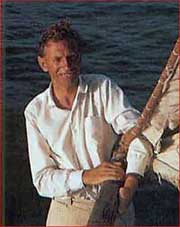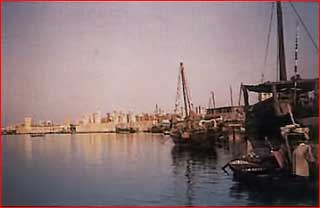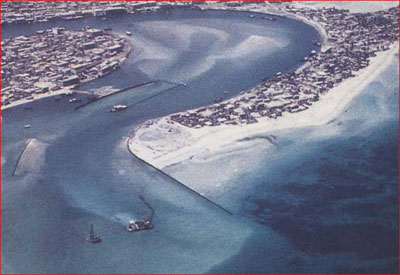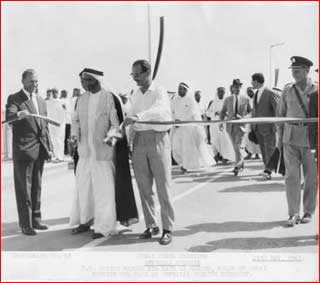
 In 1995 it is difficult to believe that at one time I had never heard mention of a place called Dubai. I had read a number of books about Arabia and the Gulf but never heard of the Trucial States until I joined the consulting engineering firm of Sir William Halcrow and Partners in 1953. I then became involved in a feasibility study to open up the silting creek harbours in Dubai and Sharjah. This was a propitious beginning for me with Halcrow for it forged an indirect link with an undeveloped part of the world in which I was particularly interested.
In 1995 it is difficult to believe that at one time I had never heard mention of a place called Dubai. I had read a number of books about Arabia and the Gulf but never heard of the Trucial States until I joined the consulting engineering firm of Sir William Halcrow and Partners in 1953. I then became involved in a feasibility study to open up the silting creek harbours in Dubai and Sharjah. This was a propitious beginning for me with Halcrow for it forged an indirect link with an undeveloped part of the world in which I was particularly interested.
Following completion of the feasibility study, I joined the staff at Halcrow's Kuwait office on the construction of a deep-water harbour at Shuwaikh. In Kuwait, I met Peter Reilly, the British Treasury representative in the Gulf. Peter was involved in the financial aspects of the project and naturally was pleased to meet someone who had been directly connected with the feasibility report. Again Dubai came to my attention. The link with the Trucial States took on a more concrete form in the early summer of 1956 when I was sent to Dubai for further investigation of the creeks. The investigation team lived in the old Imperial Airways Fort at Sharjah airport. Each day we travelled in a Land-Rover over the empty sabkha flats separating the two towns. We were well cared for at the Fort, but the lack of effective air-conditioning made sleep in the high humidity of the summer nights nigh on impossible. Driving some distance into the desert and sleeping on camp beds under the stars eased the problem a little.

Photographs studied during the preparation of the feasibility study had led me to expect something special and picturesque of Dubai's harbour and town, but what I found far outdid my expectations. Yes, there were the white buildings with the wind-towers lining the Creek. There was the S-shaped channel connected uncertainly with the open sea at the end of the Shindaga sand spit, flanked on each side by sand banks - the problem to be solved set out before our eyes. Native craft plied the Creek in greater numbers than I had expected and in a greater variety of shapes and sizes compared with those in Kuwait. The photographs, however, had failed to convey a true impression of the variety of peoples and the diversity of dress of those thronging the covered suqs; the steady flow of abras and ferry boats across the Creek; and the general hum of activity on land and water - the hallmark of Dubai, even in those days the busiest port in the southern Gulf. A short journey out of Dubai or Sharjah confirmed that the empty spaces on the maps faithfully represented the facts. There wasn't a single permanent dwelling, for example, between the house which is now part of the Seamen's Centre in Dubai and the Ruler's Fort in Abu Dhabi. This entire stretch was nothing but empty sand and sabkha flats - although there was a lone gharf tree just past Jebel Ali.

Shortly after we started work on the Creek project I met His Highness Sheikh Rashid bin Saeed AI Maktoum, then the Acting Ruler of Dubai. It was immediately obvious that he was the driving force behind the harbour expansion project. There were few British Expatriates in Dubai at that time. Peter Tripp was the British Political Agent. He and his wife Rosemary lived in a bungalow near the present-day Embassy. Dr Desmond Macauley, who lived in a simple house close to Maktoum Hospital looked after the health of the entire population of this wide-open territory across which there were no roads. George Chapman, on one of his first tours of duty in Dubai, was in charge of lighterage and other activities at Gray Mackenzie. He and his wife Doreen lived in a large house with an extensive verandah overlooking the Creek. I believe George had one assistant. The British Bank of the Middle East had a manager and one assistant manager, whose names I cannot recall. Petroleum Development Trucial Coast had one manager, and a Mr Townsend was operating out of Dubai in connection with setting up oil company facilities on Das Island, in Abu Dhabi waters. Sharjah had a small contingent of RAF people and was the headquarters of the Trucial Oman Levies. Robin Huntington had just started the experimental farm at Digdaga, near Ras Al Khaimah. Sheikh Rashid kept a close watch over the Creek investigation. I was required to keep him informed of progress, and in particular to explain what Halcrow had in mind for the improvements.

Sheikh Saeed bin Maktoum, Sheikh Rashid's father, was the Ruler at that time. although getting on in years, he also showed a keen interest in the investigations, and often was to be found sitting on a long wooden bench overlooking the Creek, accompanied by his grey-bearded friends and groups of his subjects. While we conducted the Creek investigations, the navigable channel to the harbour was sometimes obstructed by our equipment. This caused considerable difficulties to boats entering or leaving the Creek, especially to the Gray Mackenzie tugs towing deeply laden dumb barges. George Chapman and his tug nakudas took it all in their stride, but their patience was sorely tried at times. The Creek investigations were completed over a period of three months. I returned to Kuwait, leaving Dubai with regrets, but with the hope that I might return to help solve the problem of the silting harbour. The Austrian Kuwait Engineering Company (AKEC) was eventually awarded the contract for the Dubai Harbour Improvement Works.
I was appointed Resident Engineer and returned to Dubai early in January 1959. The Dubai of 1959 was little different from the Dubai I had left in 1956, although Sheikh Saeed had died and Sheikh Rashid had become Ruler. The British community - although still small - had changed considerably. Donald Hawley was the Political Agent, with Harold ('Hooky') Walker the Assistant Political Agent. Dr Macauley was still looking after his far-scattered patients, but the BBME, Gray Mackenzie and the oil companies all had new men. The arrival of AKEC more than doubled the number of European Expatriates and was the start of the huge expansion that transformed Dubai. I was installed in a prefabricated bungalow built by AKEC near the entrance to the harbour, close to the Al Ghurair family home. My wife Heli and our five-month-old twin sons joined me in September 1959. We lived in this house for more than eight years. The Deira Suq was almost on our doorstep and the traders quickly grew accustomed to the sight of Heli pulling a pram with two babies on board (pushing the pram in soft sand was physically impossible). We received a warm welcome from the Al Ghurair family and other neighbours and this made us feel part of the wider community: this was the beginning of our indelible attachment to Dubai.

The main bonus and attraction of the job in Dubai was the welcome given by the Ruler, as well as the people of Dubai. Sheikh Rashid was at pains to assure everyone connected with the Creek project that their personal efforts were important and were appreciated by himself and his people. In keeping with his desire to maintain close contact with his people, Sheikh Rashid held an informal Majlis every morning. If I had anything to report, or required any decision from him, I would attend the Majlis and await my turn with the rest. Attending the Majlis became an enjoyable feature of my life in Dubai and I formed a number of friendships at the Majlis. Although I am not an Arabic speaker, I was able to appreciate the process taking place and to admire Sheikh Rashid's method of dealing with his people. I well remember his tall figure relaxing in one corner of the long room with his friends, while his subjects and visitors sat along the other walls. His strong and unmistakable face would be alert to everything taking place in the room, and at the same time he would be keeping note of shipping movements in the Creek. These occasions were mostly very relaxed and frequently became hilarious when the Ruler, in mischievous mood, allowed his strong sense of humour free rein.
Dubai Creek Improvement was the first major development project in the lower Gulf and was all the more remarkable for being undertaken in a country without oil revenues. It was typical of the vision that so dramatically transformed Dubai over the next three decades. Although revenues were limited in those days, plans were soon in hand for an orderly progression of infrastructural development. In this respect, the Ruler was fortunate to have the sound advice of Donald Hawley, who had previously served in Sudan where he was responsible for development and Municipal affairs. Aerial surveys of Dubai were undertaken and John Harris, a British architect and planner, was appointed to prepare a Town Plan. The Municipality was reorganised, medical and education facilities were expanded, and work began on the development of services such as water, electricity and telecommunications.
Sheikh Rashid soon had a small group of British advisers around him, including Eric Tulloch and Bill Duff. The Ruler placed great reliance on his advisers and they responded loyally to this trust. Sheikh Rashid set Sir William Halcrow and Partners the task of designing the first bridge across the Creek. The first proposal did not meet his budget plans and the project seemed to go into abeyance. Later, however, at a dinner hosted by the Ruler of Qatar, who was also Sheikh Rashid's son-in-law, Sheikh Rashid called Bill Duff and I across the Majlis and inquired about the cost of a bridge at an alternative site where the Creek was narrower. Bill was able to confirm from his pocket diary the estimated cost of the original plan and I was asked to make a pro-rata guesstimate of the probable cost of the second option. There was no way out for me, and I warily pronounced a figure.
Al Maktoum Bridge was opened to traffic in May 1963, forming the first fixed link between Deira and Bur Dubai and opening up the city for further development. The next key stage was construction of a runway and associated taxiways and aprons to accommodate BOAC's VC-10 passenger jets and similar aircraft. As the project neared completion, BOAC indicated a reluctance to commit to a weekly service to London, fearing there would never be sufficient passengers to warrant it. In the end, each British company operating in Dubai guaranteed a specific number of passengers, and Sheikh Rashid guaranteed commercial traffic to make up the shortfall. This laid the foundations for an international airport which is now one of the busiest in the Middle East and one of the most efficient in the world. BOAC's reluctance to introduce an air service was typical of outside attitudes in those days. Many so-called experts believed that Sheikh Rashid's vision was over-ambitious, but Dubai's subsequent development confirms his judgement.

With the discovery and exploitation of oil resources, Dubai's aspirations increased and so the size and scale of projects also increased. Sheikh Rashid continued to appoint Halcrow as consulting engineers for many of the most important development tasks to be undertaken. The next major project at this stage was Port Rashid, the first deep-water general cargo harbour in the southern Gulf and a vital ingredient in Dubai's development as one of the world's leading maritime centres. This was followed by the Shindaga Tunnel and Dubai Dry Docks, one of the largest VLCC repair yards in the world. Halcrow were also responsible for a sea wall project and land reclamation at Deira, and building of the Dubai-Oman road via Hatta.
One of the high points of my own career came in 1976 when I was called to Ras Hasa, not far beyond Jebel Ali, to attend upon the Ruler at about five o'clock in the morning. Sheikh Rashid said he had decided that a new industrial harbour would be built amid the low-lying sabkha flats which earlier had been used as an artillery and bombing range. He had a firm idea of the number of berths he wanted and was able to indicate the location of the quays and the entrance channel. I was allowed no opportunity to avoid giving him an indication of the probable global cost. He there and then decided he would proceed with the project and instructed that certain preliminary work should start within days. Jebel Ali Port - the biggest man-made harbour in the world - has since added another important chapter to the Dubai development story.
In 1976 I had to return to the UK for a series of eye operations to save my sight. Halcrow gave me a year's sabbatical leave, after which I returned to Dubai at Sheikh Rashid's request. After being retired from Halcrow I set up my own company. This company completed five underpasses in Dubai, and since then has been employed on various works for a Dubai Government Department. I still live in Dubai. Up-to-date maps of the UAE show rather fewer empty spaces than the maps of 1956 and I am happy to have been associated with some of the projects that have changed the face of this land. I am grateful to the late Sheikh Rashid bin Saeed Al Maktoum for giving me the opportunity to serve him and the peoples of Dubai.
Nevil Allen 1995 - Photos are Copyright of Nevil Allen








